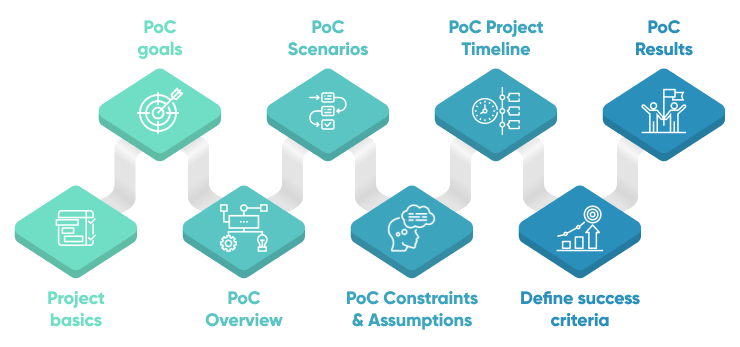If you're working on a new product or service within a large organization, you know that a proof of concept (PoC) is crucial for gaining top management support. But creating a PoC can be a complex process, with many different stages and success criteria to consider.
Our proof of concept template will help you simplify the process and ensure that your PoC provides optimal business value. We will outline the key elements of a PoC, including project constraints and assumptions along with a process for gathering feedback at the end of your project.
With this template, you can be confident that your PoC will help you get the support you need to move forward with your new product or service.
So if you're ready to get started on your PoC, read on!
What is a proof of concept?
A proof of concept is a demonstration of the feasibility of a particular software project, product, or business idea. While not a required part of every new product development process, this very early stage assessment of feasibility can help to reduce project risk and prevent investment in a project idea or IT product or service that doesn’t fulfill business and technical requirements.
In IT, a proof of concept can be used for a variety of reasons including to:
- Demonstrate feasibility of a software project, product, or business idea
- De-risk investment in a project idea
- Determine financial viability of a particular software project
- Check technical viability of a particular technology
- Validate market demand or customer interest in a product idea
- Test an IT product or service’s ability to meet requirements before making a buying decision
Because a PoC can be used for many purposes, it can come in many forms. If it is meant to test whether a purchase decision should be made, it will involve thoroughly testing the software during a free trial/evaluation period. If, on the other hand, the PoC is meant to validate market demand, you might build a landing page or a marketing video targeted at potential customers.
The unifying idea is that a proof of concept should be a low cost and relatively quick project. A software proof of concept is typically developed as an internal project with a small group of people to help keep costs down. However sometimes a custom software development company will be brought in to develop the PoC for a new startup that doesn’t have adequate resources internally.
PoC vs prototype vs minimum viable product

A proof of concept is often confused with a prototype or a minimum viable product, but they are each distinct phases of the software development lifecycle.
A prototype is typically where your product becomes tangible for the first time. This working model is meant to give teams an idea of what they are going to build - a way to visualize things for the first time. The level of detail of a prototype can vary significantly. The lowest budget option would be to sketch out a design with pen and paper. More advanced prototypes can be created in tools such as Figma. When deciding on the type of prototype for your product, consider your budget and timeline. These two elements will dictate how complex your prototype can be.
A minimum viable product (MVP) is the most basic version of working software that can be released to real users. Typically work done on a prototype will be used to build the minimum viable product. As the MVP is released to customers in your target market, the development team can get valuable data on what works and what doesn’t work. This data will be used to create later versions of the product.
Why use a proof of concept template?

Proof of concept templates can be a helpful tool for anyone who is developing a new product or service and needs to secure management support for the project, validate technical feasibility, or simply de-risk their investment.
To get the most value out of your PoC and ensure it doesn’t go past schedule, you need to have a very well defined plan and a structured approach to testing and validation during the proof of concept. For example a VOIP company PoC took 28% longer when it was not coordinated strategically. Strategic coordination is key!
This type of coordination is most easily accomplished by way of proof of concept templates. By outlining the key components of your proposed offering along with defined success criteria, you can:
Secure top management support
The most crucial element for project success is “top management support” according to research. A proof of concept template is crucial for project managers and teams to gain top management support for new technology initiatives. They allow managers to verify the quality of solutions, ensure it aligns with the company’s long term business plan, and learn more about costs and timelines required for full implementations.
Validate feasibility of IT project
A PoC template provides a means for teams to lay out in detail the technical functionality that needs to be validated during the PoC process. This will be followed by corresponding proof of concept tests that validate the proposed idea or software. Furthermore, the template will provide a means of documenting findings that the team found in the real life testing, which will help management and team leads decide if the project teams should move forward or not.
De-risk investment in business idea
Product teams as well as management will certainly be looking to de-risk the project before moving forward. A successful proof of concept will do just that. A POC template can help you systematically identify and mitigate key risks for your new product or service such as:
- Value risk - misreading market demand is the #1 reason tech startups fail — this is found in 42% of cases
- Usability risk - 25% of project failures are attributed to UX design issues
- Feasibility risk - 45% of software projects are over budget, while delivering 56% less value
8 step proof of concept template

Project basics
In this first section of your proof of concept template, the project lead should fill in the basic details of the project including the project’s name and a list of everyone who will be involved in the proof of concept.
In many cases your PoC will involve testing out a software system that may be used for your product or service development. In this case, you’ll want to list the team members of the software company who you will be interfacing with during testing.
PoC Project Name: [PROJECT NAME]
PoC Project Client: [CLIENT NAME]
| Project Member | Company (i.e. internal or external?) | Role in the PoC Project |
| [NAME] | Internal - [YOUR COMPANY NAME] | [PROJECT ROLE/JOB DESCRIPTION] |
| [NAME] | External - [COMPANY NAME] | [PROJECT ROLE/JOB DESCRIPTION] |
PoC goals
Consider the goals of your proof of concept. What are you trying to validate? What issues are you trying to identify proactively? Make sure you survey stakeholders in the marketing, product, and IT teams to ensure everyone’s goals are thoroughly documented. It’s also a best practice to ensure your POC goals align with a larger business plan for your product or service.
As your goals are achieved, document them in the Goal Status column. This will make it easier to develop a PoC summary after work is complete.
| Goal | Goal Status (demonstrated/met) | |
| 1 | To test whether [TECHNOLOGY/APPLICATION/SYSTEM] can be used to achieve [DESIRED OUTCOME]. | |
| 2 | To identify any potential issues with using [TECHNOLOGY/APPLICATION/SYSTEM] to achieve |
PoC Overview
In this section, provide a written and graphical depiction of the PoC project. Think about how you would, in brief, describe your PoC project to someone who is uninvolved in the project. Provide an adequate amount of detail to support that here. If you will be testing the integration of software systems, show a block diagram.
PoC Scenarios
Describe the high level scenario(s) that will be demonstrated during your proof of concept. Where applicable, provide a network diagram to support each scenario. If you have specific project requirements you are testing in various scenarios, list them in the Requirements column. Provide comments and document feedback throughout testing in the Comments column.
| Scenario | Requirements | Comments | |
| 1 | What you will test, demonstrate, or build | Requirements the scenario will fulfill | |
| 2 | |||
| 3 |
PoC Constraints & Assumptions:
Every proof of concept project will have an inherent set of constraints - whether it be a short time frame, a limited budget, software feature limitations or something else. Be sure to clearly document those here along with any assumptions your team is making.
Experienced product leaders will know that assumptions made early in the project can wreak havoc later, so be sure to lay them out clearly, so you can ensure you are on the same page with management and are able to provide optimal business value.
| Constraints | Implication of Constraint | |
| 1 | Scope, Budget, Resources, Time, etc | |
| 2 | ||
| 3 |
| Assumption | Source of Assumption | |
| 1 | Division of Responsibilities, Integrations, Dependencies, etc. | |
| 2 | ||
| 3 |
PoC Project Timeline:
Use this section to document your intended start date for the proof of concept work along with when you expect to have a demonstration you can show to stakeholders. POCs being iterative in nature mean that you may end up spending much longer than you initially anticipated on your proof of concept. Documenting specific progress dates can help you avoid the project extending longer than it needs to.
| What is the PoC start date? | [DD/MM/YYYY] |
| (First) Demonstration target date | [DD/MM/YYYY] |
| PoC stages target dates (optional) | [DD/MM/YYYY] |
| When is the PoC considered completed? | When [COMPLETION REQUIREMENT], the project is considered complete. |
Define success criteria
Explain how you intend to verify that the goals you presented in step #2 have been satisfied. Use the success types listed to identify the category the success criteria falls under. This will help you distinguish between different areas of the proof of concept project more clearly.
As success criteria has been met, provide documentation here.
| Success Criteria Type | Success Criteria Details | Success Criteria Status (met?) | |
| 1 | Functional, Performance, Scalability, Availability, Service Quality, etc. | ||
| 2 | |||
| 3 |
PoC Results (after POC completed)
After your proof of concept work has concluded, it’s time to complete a project wrap up and present your findings to relevant stakeholders and management. As a starting point you should:
- Fill out Goal Status column in step 2
- Fill out Success Criteria Status in step 7
Next, you should document your team’s recommendations for a move-forward plan. Consider all of the information gathered during the course of your proof of concept work when documenting your own recommendations. After meeting with management, it’s a best practice to document if your recommendations have been approved or rejected here.
| Recommendations | Recommendation Status (approved/rejected/etc) | |
| 1 | Further testing/validation of [TECHNOLOGY/FEATURE/ETC] | |
| 2 | Do/don’t move forward with [SOFTWARE VENDOR] for [PROJECT] | |
| 3 |
Get proof of concept template (Google Doc)
Ready to download the proof of concept template for yourself? Get your own copy here!
Need help with your Proof of Concept?
Need some support to get your proof of concept project off the ground? Or are you looking for an end-to-end software development partner to help you validate your idea and move right into development? At SoftKraft we provide Software Product Development Services. We take project ownership and responsibility for decisions that were taken during the development. Success of the project is the only metric that really matters to us.
Conclusion
A proof of concept can help teams to secure top management support, validate technical feasibility of a new idea, and de-risk further investment. While a PoC can take many forms, from testing a software system during a trial period to interviews with the target audience, a proof of concept template can always serve useful for teams looking to approach their PoC project systematically and provide greater business value.
We hope you find the proof of concept template we have provided helpful as you kick off your own PoC project!







